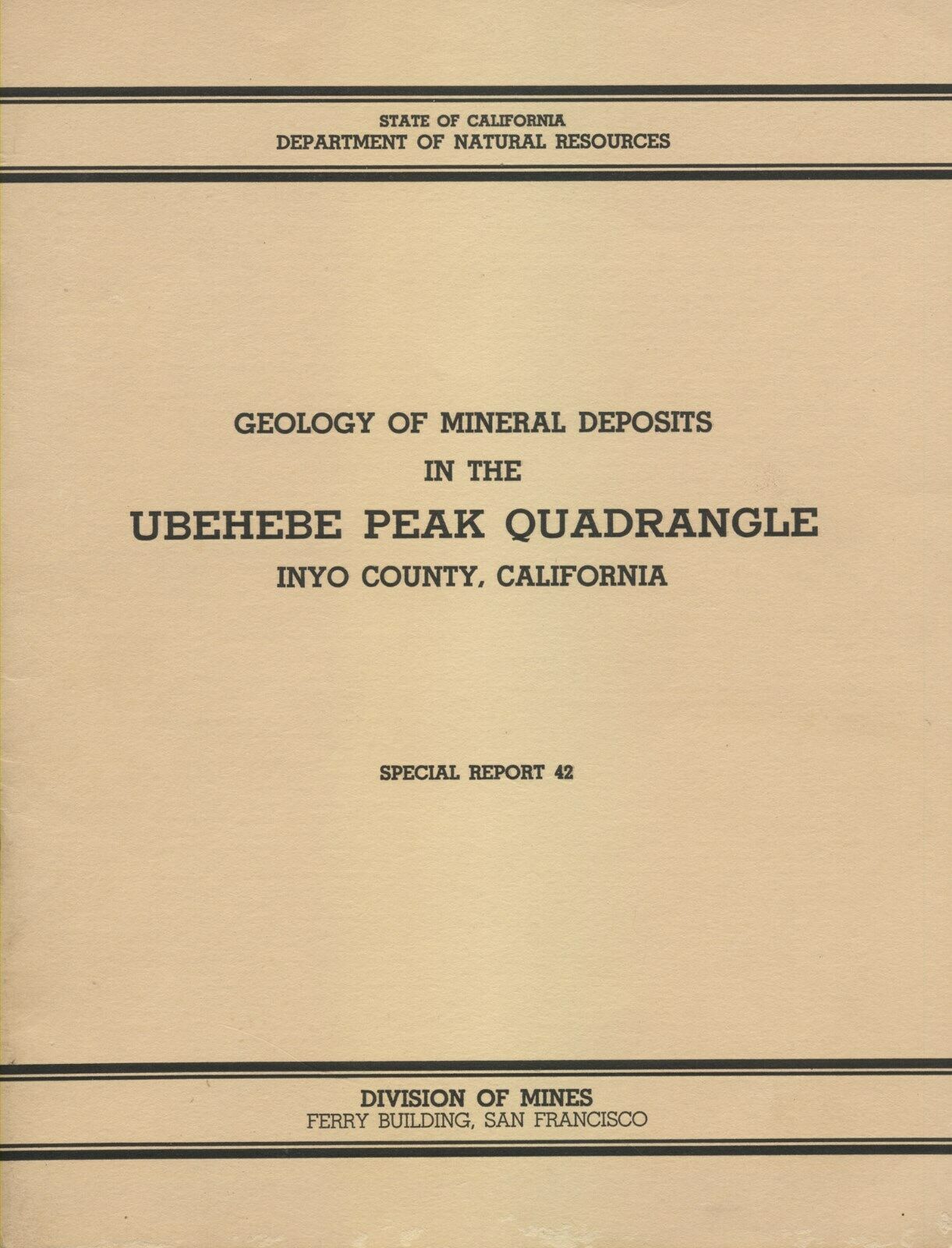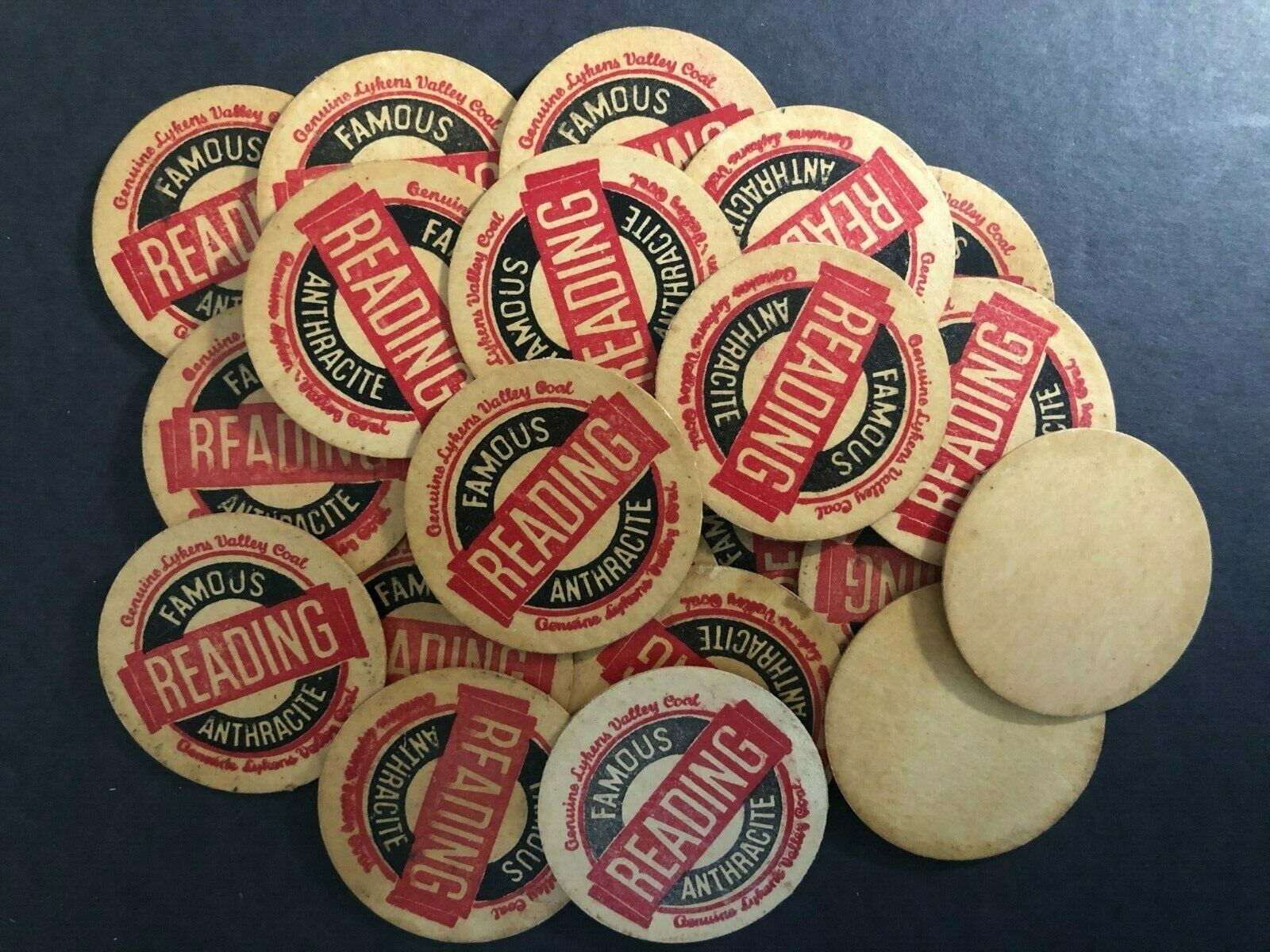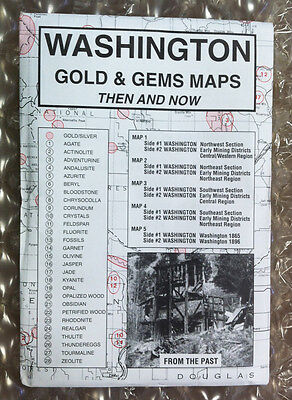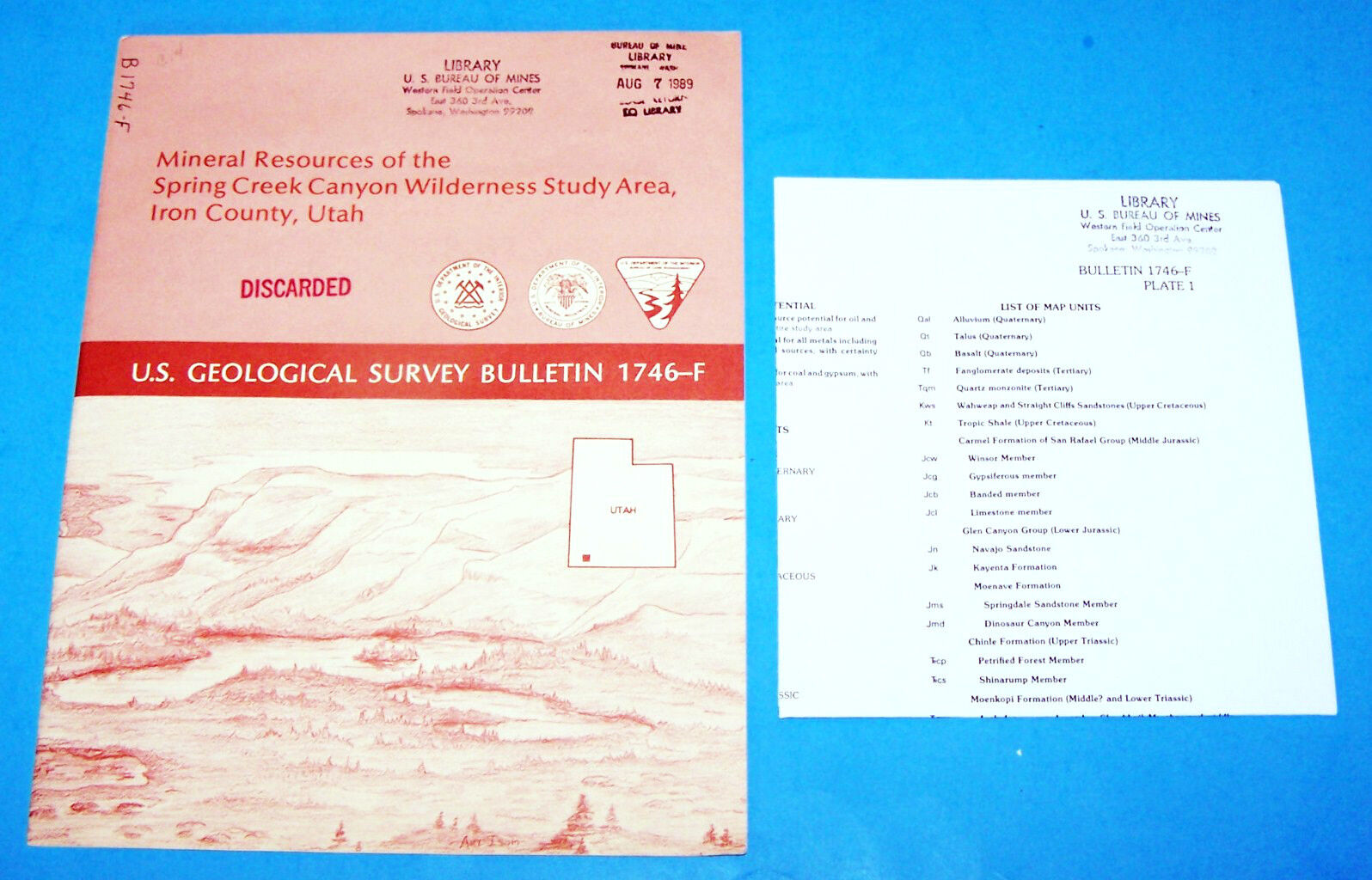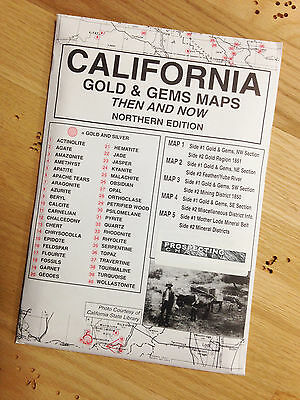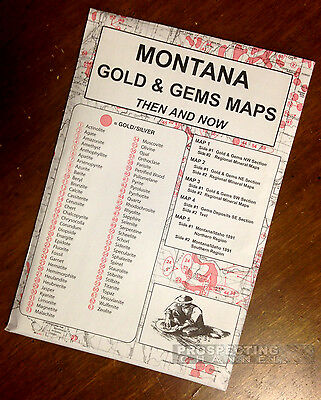-40%
Death Valley gold silver mines, Ubehebe, Inyo, Calif; RARE old 1st ed report, VG
$ 35.25
- Description
- Size Guide
Description
RARE 1st ed. and BIG maps describe gold & silvermines in Death Valley's famous Ubehebe District
Includes parts of Saline Valley, the Panamints,
Hunter Mountain, Racetrack and more;
some mines date back almost 100 years
Report and maps are in beautiful condition
Small detail of Figure 25:
Geologic and topographic map of the Sally Ann area.
Note mine's proximity to the Racetrack dry lake playa, home to Death Valley's famous roving rocks, huge boulders that somehow move around by themselves.
F
inding another of these rare reports to sell (on Death Valley's historic Ubehebe Peak quadrangle) took me over TWO YEARS.
When a collector gets one of these, they won't sell at any price. No wonder: This is the ONLY full-length report on silver and gold mining AND geology in this famous but remote area in Death Valley.
Not only is the first edition very hard to find, but snagging one in beautiful condition like this copy is doubly difficult. Matter of fact, this is the nicest copy of this valuable and useful report that I have seen. Yes, it also has all three oversize maps in the rear pocket, in near fine condition.
Small detail from map in pocket:
Geologic and topographic map of the Ubehebe mine, Inyo County, California. (Some rippling at bottom of map not shown.)
Not available in Death
Valley tourist traps
You won't find this out-of-print first edition in Ye Olde Stovepipe Wells Gift Emporium, wedged between
the Slim Jims and the cheesy "I-survived-Death-Valley" T-shirts. It is written about miners for miners by miners.
Dried-up beef jerky
But that doesn't mean it's all technical. There's plenty for the nongeologist — from spring locations to predominant area vegetation at various elevations. And water-source locations are the difference between life and death in aptly named Death Valley, which claims tourists' lives on a regular basis every couple years. Famous last words: "Nah, I don't need any extra water, Gunther. It's 115 degrees but only 5–6 miles to that mountain top."
So don't be like Gunther's pal, who was found a couple weeks later looking like dried-up beef jerky! If you're planning a trip to the Ubehebe area, be prepared! Buy this report now or forever hold your peace. Once it's gone; it's gone.
Not interested in looking for gold? Maybe photography is your thing or just plain backcountry exploring? Nothing like an eye-catching mine in the foreground for a prize-winning photo. Or maybe you need a worthwhile destination for that day hike near the Sally Ann mine?
Filled with info
This 59-year-old report, by James F. McAllister of the USGS, contains a wealth of information on mine locations, subterranean workings, mine production, minerals mined, mine geology and geology of the Ubehebe Peak quadrangle — all 240 square miles of it.
Like other sought-after mining and geology books about the Death Valley area, the big folded maps are arguably the real prize here. Any and all would look
great
framed if they weren't so useful in the field. Then again, you could have the best of both worlds: Make color copies of the maps for the field, and frame the originals. All are handsome examples of geologic cartography with pleasing colors and nicely executed calligraphy; they just don't make 'em like this any more (see examples below and above).
One panel (about 5 X 9.25 inches) of four-color 15.5 X 17.5 inch map in pocket:
Geologic and topographic map of the Lippincott mine area, Inyo County, California.
Just because the maps are nice doesn't mean that the report itself is a slouch by any means. Far from being all dry geology-babble, it has many facts and figures about productive mines in the quadrangle, which contains all of the old Ubehebe mining district, which was first known for scattered copper deposits and later for gold, silver and lead.
Area produced substantial
silver and gold
We're not talking descriptions of a few dinky little prospect pits here: From 1908 until 1951, the area produced 4,788 tons of ore containing 334 ounces of gold; 44,729 ounces of silver; 120,180 pounds of copper and 2.6
million
pounds of lead. And these figures
do not
include earlier gold production, which the book estimates at an amazing 2,000–4,000 ounces of gold alone. That's .6 million at today's prices.
The maximum recorded annual production of lead and silver was 1.12 million pounds of lead and 15,222 ounces in silver from the Ubehebe mine in 1928 +ALONE+.
The book hints that both production and exploration were "impeded" by the area's rugged inaccessibility. In short, good roads or — better yet — a railroad was needed to get the ore out and workers and supplies into the mining area. Without that, miners pretty much gave up. But that was back when gold was a mere 25 bucks an ounce. It is now 56 times that!
Well, you say, Death Valley National Park which doesn't allow mining. Not true. Mining is still possible in Death Valley if you want to do the paperwork.
Ever been to the Lost Burro winze?
This report is considered primary source material. Ever been to the 5,520-foot level of the inclined winze of the Lost Burro gold mine? This book will show you how to get there and what to expect when you arrive.
Want to know where the closest spring is to the Sally Ann deposits near Racetrack playa; how many ounces of silver that the Farrington Mine produced in 1913 (1,268); where to find garnet in the Nelson Range; or what local rocks are associated with lead-zinc deposits? It's all here. The vintage photos are especially helpful in finding old prospects. Mine buildings and roads may be long gone, but the terrain is still the same. Just match up a distinctive hill or rock outcrops with the photo.
Recovered materials from this area include:
Salines and borates (Saline Valley), talc, asbestos, lead-zinc-silver, gold, copper, tungsten and more.
Mines and prospects covered include:
Ubehebe Mine (lead, silver, zinc).
Lippincott (Lead King) Mine (yes, that's THE Lippincott Mine, theoretically accessible from Saline Valley via perennially washed-out Lippincott Mine "Road").
The Cerrusite Mine.
The Shirley Ann (Eureka?) deposit.
Lost Burro Mine (gold).
Sally Ann area.
Copperbell Mine, Ubehebe Peak area, Hidden Valley area, Dodd Springs area, Nelson Range.
Cuprotungsite (Alvord?) claim and the Monarch mine, among others.
Those are the major mines covered. Other mines, minor in terms of official output but not necessarily in terms of diggings, are also described.
Illustrations include:
Photo of the Ubehebe Mine area.
Composite map and projection of the connected workings in the Ubehebe mine.
Geologic map of the Ubehebe mine.
Geologic maps and section of Confidence workings, Lippincott mine.
Geologic map of workings at adit A, Cerrusite mine.
Geologic map of the Shirley Ann area.
Photo of Lost Burro mine site. Composite and geologic maps of the Copper Bell mine and more — for a total of two tables, 10 maps of aboveground features, 12 subterranean (mine) maps, 10 photos, one drawing and three oversize maps in rear pocket.
Book describes geology in detail
Because this is, after all, a book about mining
and
geology, it covers the latter topic in minute detail. Matter of fact, before this book, "little information about the geology of this area (was) published." Metal deposits generally occur in the Paleozoic sedimentary rocks that range from Ordovician to Permian, near intrusive contacts of Mesozoic quartz monzonite; but a few occur in the intrusive masses.
Of course, the text contains far, far more detail about geology — especially how it relates to mineral deposits and their formations — than just the previous two paragraphs. Geology varies widely over an area the size of this quadrangle, so it is impossible to convey but the simplest geologic features in an ad.
Where is it?
To see just how much real estate this 63-page text covers, please see the map, below left. The quadrangle is pretty much in the middle of nowhere. Only roads to the quad are unpaved, and most require a vehicle with highish clearance. BUT
four-wheel-drive is usually NOT necessary for most of the main roads.
Then again, where did you expect to find a gold deposit of this size in 2015? In Topanga Canyon or underneath the planters at South Coast Plaza? So you have to put a few miles on your new SUV or better yet, on your well-used 1985 Toyota SR5 pickup? Big deal. That's what you bought those vehicles for! Time to get off the beaten track and explore a little backcountry before the gas prices go back up.
The southwest corner of the quadrangle is about 32 miles from Keeler, which is another 18 miles by road from the nearest gas station, grocery store and motel in Lone Pine, California, in Owens Valley, at the foot of Mt. Whitney. The tiny Mojave Desert ghost town of Darwin is a bit nearer, but it has no services, not even a pay phone, only a post office.
Generally, the book explores: Lee Flat (
not
the Lee Mines proper; those are in the Darwin Lead-Silver District), the Nelson Range, part of Hunter Mountain; part of the Panamints, Ulida Flat and Hidden Valley; southwestern Saline Valley (Grapevine Canyon, the salt lake, not specifically the hot springs, although they are discussed), Ubehebe Peak and Ubehebe Mine. The quad also includes Racetrack, the dry lake playa where boulders move around by themselves. Surprisingly, Ubehebe Peak quad does not contain the Ubehebe Craters!
Ubehebe quadrangle is in Inyo County, about 270 road miles northeast of Los Angeles and 126 miles from Kern County. Nearest towns with supermarkets and chain stores are Ridgecrest and Bishop, CA, both about 140 highway miles away. Interestingly, some of the roads to mines in this quadrangle are plainly marked on the Auto Club Death Valley road map, so the road map can be used easily to correlate some exact mileages to mines and other geologic features and mines on the large maps from the report.
The book:
Geology of Mineral Deposits in the Ubehebe Peak Quadrangle, Inyo County
, special report 42, January 1955, by James F. McAllister (USGS), State of California, Department of Mines, San Francisco, 63 pages. Stapled binding, stiff paper covers, a very nice copy, definitely the best I have seen.
Front cover and back cover are in NICE shape. Three maps in pocket are folded with some slight rippling, otherwise in fine shape, bright white. Owner's name stamped on cover.
Payment methods
and domestic shipping
Paypal only. I pride myself on bulletproof packaging. FREE shipping via priority mail, not slow-as-a-snail media mail. You'll get it in 2-3 days, NOT 2-3 WEEKS like media mail.
The fine print:
Feel free to contact me if you have any questions about the item or terms of sale.
I post feedback once a week. Not responsible for typographical errors.
Good luck and thanks for looking!
Small detail of Figure 23:
Composite map of workings, geologic map of main levels, and longitudinal section of the Lost Burro (gold) mine
.
Small detail from figure 12:
Geologic map of the Ubehebe mine.
Where is it?
Death Valley National Park (DVNP) is located mostly in southeastern California; some of it crosses state lines into Nevada. Most of DVNP is in Inyo and San Bernardino Counties, California.
Counties adjacent to Inyo are Mono, Fresno, Tulare, Kern and San Bernardino; nearby counties include: Riverside, Orange, Los Angeles, Santa Barbara, Kings, Madera, Mariposa, Tuolumne and Alpine.
Towns, population areas and interesting sites in Inyo County include Aberdeen, the Alabama Hills, Ancient Bristlecone Pine Forest, Badwater, Ballarat, Big Pine, Bishop, Cartago, Cerro Gordo, China Lake Naval Weapons Center, Coso Junction, Darwin, Death Valley Junction, Dolomite, Dunmovin, Eureka Sand Dunes, Fossil Falls, Furnace Creek, Haiwee Reservoir, Independence, Keeler, Laws, Lake Sabrina, Little Lake, Lone Pine, Marblehead Acres, Mt. Whitney, Olancha, Owens Lake, Panamint Springs, Pearsonville, Saline Valley, Scotty's Castle, Shoshone, Stovepipe Wells, Swansea, Tecopa and Ubehebe Crater.
Track Page Views With
Auctiva's FREE Counter
